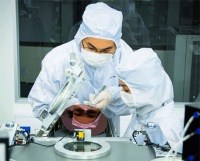The £61m National Graphene Institute (NGI) at Manchester University was officially opened on March 20, 2015 with the LED bulb set to launch later in the year.
The LED bulb – which is claimed to reduce energy use, last longer than similar products, and cost less to manufacture – is set to enter a global market estimated by Statista to be worth €64bn between 2011 to 2020.
Graphene, a two dimensional material consisting of a single layer of carbon atoms arranged in a honeycomb structure, is the thinnest, and one of the strongest, known materials that is also feted for its conductivity and heat resistance. The material was first isolated at Manchester University by Andre Geim and Kostya Novoselov in 2004, earning them the Nobel Prize for Physics in 2010.

“Compared to a leading LED - based on an equivalent lumen – this [bulb] will use less energy,” said Prof Colin Bailey, deputy president and deputy Vice-Chancellor of Manchester University, adding that issues around commercial confidentiality remain in play prior to the bulb’s commercial launch.
He did, however, say that the new light bulbs use more sustainable components and that fewer steps are required to manufacture them compared to LEDs already on the market. The use of graphene also puts the new bulb at an advantage, as it will outperform those elements in traditional LEDs that eventually degrade.
Graphene Lighting PLC, a spinout based on a strategic partnership with NGI (NGI) at Manchester University, will produce the light bulb and other graphene products.
“We’ve got the all the prototypes done, we’re checking the robustness of our supply chain, [and] we’ve got investment,” said Prof Bailey. “We’re going through the closing stages of certification both in the US and in Europe and the first run of light bulbs will hit the market pretty soon.”
Prof Bailey said another product close to market is a passive RFID antenna which is likely to be commercialised by early 2016, with numerous other projects ‘moving through the innovation chains’, including: membranes for water purification, protective coatings for steel or masonry, batteries, and applications in drug delivery.
“We’ve prototypes for composites and composite devices and again we’re looking to see how we can drive that to market for aerospace components. In aerospace you’re talking 20 years plus to get those to market, but for non-critical components we’re looking to get there quicker,’ he said.
Key to these developments is the NGI, which will see academic and commercial partners working together on graphene applications of the future. It is funded by £38m from EPSRC and £23m from the European Regional Development Fund (ERDF) and will develop applications to displace existing products based on cost and quality.
“Here in Manchester we’ve the knowledge base that allows us to take things right through the innovation chain,” said Prof Bailey. “With [NGI] we can really start accelerating the use of graphene and advanced materials to market, which is good for the UK economy, good for the local market but also we’re looking at how we can use graphene for the Grand Challenges, so water purification; for energy, looking even at sustainability – renewables for example - and how we can use this new material to push the boundaries of those challenges further.”
Looking forward, the development of a so-called Graphene City in Manchester will be bolstered in 2017 with the opening of the Graphene Engineering Innovation Centre, which will complement the NGI and initiate further industry-led development in graphene applications.




Nanogenerator consumes CO2 to generate electricity
Whoopee, they've solved how to keep a light on but not a lot else.